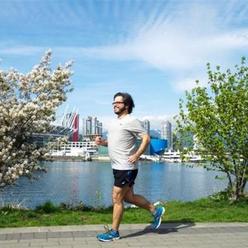Like many niche professions or sub-cultures, runners have their own language that can often seem incomprehensible to novice runners. Here is part 2 in my series of posts that takes an in-depth look at a “running lexicon” of words you will be sure to hear if you hang out amongst runners for long enough. If you missed the first installment, you can catch up here.
![]()
Heart rate: The number of times your heart beats in a minute. Training by heart rate accounts for many variables that affect how you feel from day to day. This makes it a better way to check how hard you’re working than an arbitrary measure such as your pace. The key is to know what your maximum heart rate is; once you know that, you can figure out the range of heart rates that correspond to the effort level you want for a given run.
Hitting the Wall: The point in a longer race where a runner felt like he or she can’t run another step. This happens when a runner depletes his or her glycogen stores. Runners can avoid hitting the wall by carbo-loading before a race and following a progressive training plan. See Bonking.
Ice Bath: Submerging your legs in ice water after a run. This is said to reduce inflammation and aid in the post-long run recovery process.
Interval training: Alternating specific time periods of high and low intensity efforts during a run.
IT Band: The iliotibial is a thick band of fascia running from the hip, down the thigh, across the knee, and through the shin. The band helps stabilize the knee during running, moving from behind to the front of the femur during activity. It is a common source of injuries for runners.
ITBS: Iliotibial band syndrome is one of the leading causes of lateral knee pain in runners. It is caused by inflammation due to the rubbing of the band over the thigh bone (femur), combined with the repeated motion of the knee during running.
Junk Miles: Miles run at an easy pace without a specific purpose other than to reach a certain weekly or monthly mileage.
Kilometre: A metric measure of distance, often abbreviated as K or KM. It is a common distance measure for runners, particularly outside the US. Even in the US, kilometres are commonly used to denote popular racing distances like the 5 and 10K.
Kick: The final push runners give near the end of a race to increase their speed to the finish line.
Lactic Acid: A compound produced when glucose is broken down and oxidized during normal metabolism and exercise. During intense exercise when oxygen levels are lower, more lactic acid is produced, which can produce a burning sensation in muscles due to the production of hydrogen ions. Despite the myth, however, ongoing soreness in the days following exercise isn’t du e to a buildup of lactic acid, but rather tiny muscle tears and inflammation.
Long slow distance runs. LSD runs are a staple of training for a long distance race, especially half marathons or marathons. This is another term that gets a smile out of non-runners.
Mileage: The distance a runner covers run over a given amount of time, using measured in miles/km per week.
Minimalism: A movement in running shoes away from cushioned, higher drop models that have become the norm over the last couple of decades. Minimalist advocates believe that lower, lighter models allow you to run a more natural form.
Negative splits: Running the second half of a race faster than the first half.
Overtraining: Training at a volume and intensity that exceeds a runner’s capacity to recovery capacity. This often happens when a runner ramps up their mileage too quickly. Overtraining can lead to fatigue, injury and/or burn-out.
Pace: Running speed, usually expressed as the time it takes to run a kilometre (or mile). A 5-minute kilometre means that it takes that time to cover a single kilometre. Pace is often discussed based on the type of run— i.e. “long run pace,” “marathon pace,” or“5K pace.” Race pace is then, the speed a runner hopes to maintain over a set race distance or type: “My marathon pace is 4:45.”
Pace Bunny: A runner who serves as a paces-setter during a race, with the goal of bringing runners to the finish line in a predetermined finishing time. They are often identified by the rabbit ears attached to their hats and/or poles they carry to show their proposed finish times
Pick-Ups: A training technique where runners gradually ‘pick up’ or increase their pace for a short distance, usually 50 to 50 meters. A pick-up is usually done before a race to prepare for the start and warm-up muscles or during a training run to increase running and efficiency. They have nothing to do with getting a date! 🙂 Also known as strides.
Plantar Fasciitis: Pain or stiffness in the bottom of a runner’s foot or heel, specifically the plantar fascia—the connective tissue that runs from the heel to the base of the toes. Often caused by drastic or sudden increases in mileage or improper running shoes which can cause tiny tears in the plantar fascia, causing pain and inflammation. Can usually be self-treated with rest, ice, and stretching.
Stay tuned for part III!
Your Turn
Did you learn anything new from this list? Did I miss any words you’ve heard?









